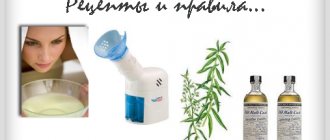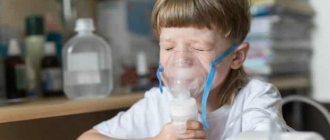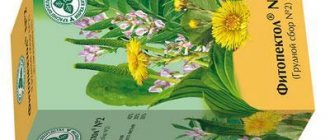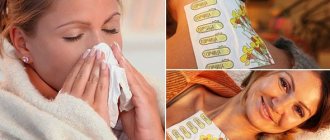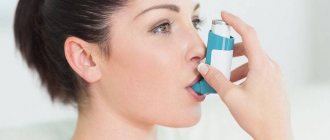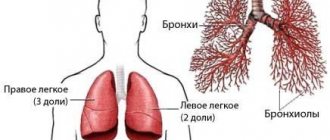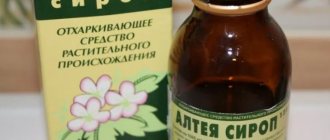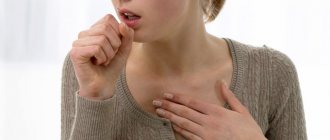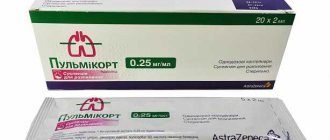Inhalations for coughs in children complement the basic treatment of colds and allergies respiratory tract. They are an effective therapy for advanced chronic inflammation, they thin, accelerate the process of removing mucus from the bronchi, significantly shorten the period of illness, and soften dry cough.
Nebulizer inhalations - how do they work?
Inhalation of a dry cough with a nebulizer allows the drug to act at the very site of inflammation. Thanks to inhalation procedures, all components of the medicinal solution reach the desired area, thereby eliminating the inflammatory process and speeding up the recovery period. Using an inhalation nebulizer, this device converts the medicinal solution into steam, which penetrates into the deepest parts of the upper and lower parts of the respiratory system. Using an inhalation nebulizer for a dry cough, you can get the following therapeutic effect:
- softens the mucous membrane;
- dilutes sputum, accelerates its discharge;
- suppresses and destroys bacteria and microbes;
- moisturizes the mucous membrane;
- relieves dry cough;
- Stimulation of sputum production;
- Eliminates bronchospasm during obstruction or asthma attack;
The properties of nebulizer therapy are versatile, since everything depends on the mechanism of action of the medicinal solution used for inhalation. An undeniable advantage of inhalation through a nebulizer is that even infants can perform the inhalation procedure.
Nebulizer medicines for cough
To relieve symptoms of persistent cough, a nebulizer is often used. For a quick recovery, it is important to choose the right solution for the inhaler and eliminate side effects. General recommendations:
- Choose a cough nebulizer, either compression or electronic mesh. These modern models are simple and effective.
- Rule out an allergic reaction to the components of the composition by studying the instructions.
- For a wet cough, choose mucolytics; for a dry cough, choose antitussives; in both cases, choose bronchodilators, anti-inflammatory, decongestants, antiseptics, and antibiotics.
- To expand the lumen of the airways, use bronchodilators.
- Do not pour pure water, undissolved medicine and essential oils into the nebulizer.
Antitussive inhalation solutions for children
Nebulizer solutions for coughs are selected taking into account the specific disease, hypersensitivity reactions, and age of the patient. In childhood, in the absence of contraindications, such treatment is safe and effective. Compositions in demand in pediatrics:
- Bronchodilators. Relieves spasm of bronchial smooth muscles. Solutions help with obstructive respiratory diseases. Salgim, Berotek, Ventolin Nebula are popular .
- Preparations with a thinning and expectorant effect. They help with impaired sputum discharge and accumulation of mucus in the respiratory tract. In pediatrics, Ambrobene, Fluimucil, Lazolvan .
- Anti-inflammatory drugs. They relieve swelling of the larynx, sore throat during prolonged coughing, and prevent blockage of the airways. Calendula and propolis are effective.
- Antihistamines and glucocorticosteroids. Eliminate the cause of cough, make you feel better. Pulmicort and Cromohexal help .
- Antibiotics, antiseptics. Harmful microorganisms are destroyed, after which the body recovers. These are Furacilin, Gentamicin, Miramistin, Chlorophyllipt.
- Immunomodulators. Strengthens the immune system during colds. Among the effective drugs for children is Derinat .
- Vasoconstrictor drugs. Recommended for laryngeal edema of various etiologies, bronchospasm. Children are prescribed Epinephrine, Naphthyzin .
- Antitussives. They stop the cough reflex, provide temporary relief, and are recommended in combination with other groups of drugs. Children are prescribed Lidocaine .
What to use for inhalation in adults
You can choose a similar solution for cough inhalation for adults. The main thing is to exclude side effects and determine the dosage. For bronchitis, tracheitis, laryngitis, the following is prescribed:
- bronchodilators ( Atrovent, Berodual ) for bronchospasms;
- antibiotics ( Gentamicin ) against pathogenic bacteria;
- anti-inflammatory drugs ( Romazulan, Cromohexal );
- to soften the mucous membrane, saline solution, salt or mineral water;
- antiseptics ( Furacilin, Miramistin ) against pathogenic flora;
- mucolytics ( Ambroxol, Lazolvan ) for the formation and separation of sputum;
- glucocorticoids ( Dexamethasone, Budesonide ) against allergies.
Inhalation with saline solution during pregnancy
During pregnancy, saline solution is safe, so it is used more often than others when treating coughs. It moisturizes and restores the mucous membrane of the respiratory system, acting independently or in combination with other components. The pregnant woman pours liquid into the nebulizer and breathes through her nose/mouth for 5-10 minutes. The procedure is repeated 2 times a day - morning and evening.
Indications for nebulizer therapy
Inhalations for dry cough with a nebulizer can be performed for almost all diseases of the upper or lower respiratory system. Indications for the procedure are also diseases of the ENT organs, against which a dry, debilitating cough may also be present. Among the main indications are:
- Bronchitis in acute or chronic form.
- Bronchial obstruction.
- Pneumonia.
- Tonsillitis.
- Laryngitis.
- Viral infections.
Inhalations can also be performed for other diseases, but only a doctor can prescribe a medicinal solution individually for each patient.
Good to know - Tonsilgon for inhalation with a nebulizer: dosages and rules.
Precautions and contraindications
Restrictions for inhalations with saline solution:
- Children of the first year of life;
- Bacterial infections;
- Otitis;
- Fever;
- Inclusions of blood in sputum;
- Cardiovascular failure;
- Disturbed water-salt metabolism.
Nebulizer therapy is contraindicated for diseases in the upper respiratory tract; there is a danger of transferring the virus to the bronchopulmonary system.
Allergic reaction to saline solution
The saline solution combines two ingredients, and their proportion is close to the fluid in the human body. Allergies can be caused by:
- Cool air flow, cold allergy;
- Silicone mask, silicone allergy;
- Concomitant medications.
If signs of an allergy appear: skin rashes, itching, burning, swelling, you should consult your doctor to prescribe antihistamines and stop inhaling.
Saline solution is not harmful to humans when used correctly. It is advisable to carry out inhalations as prescribed by a doctor. He will prescribe the dosage, frequency and timing of the procedures. Inhalations with saline solution are one of the parts of complex treatment of diseases, and if the recommendations are followed, recovery will come faster.
How to choose a nebulizer?
Recently, nebulizer therapy has become very popular, especially in those families where there are small children who often suffer from colds or bronchial diseases. Procedures using this device significantly expand the possibilities of home treatment. There are several types of nebulizer, each of which has its own application features.
Compressor. A common type of device, which many consider the “gold standard” in the treatment of bronchopulmonary diseases. Thanks to the device, medicinal particles penetrate into the deepest parts of the respiratory system, which makes it indispensable for bronchitis, pneumonia and bronchial asthma. The disadvantage of this nebulizer is its noise during operation.
Ultrasonic. They are quite compact and silent, but they tend to destroy the structure of some solutions - hormones, antibiotics.
Mesh nebulizers. They have the ability to break the healing solution into molecules and deliver steam to the site of inflammation itself. Such devices are quite expensive, but the principle of their operation is practically the same as in compressor nebulizers.
Is it possible to do inhalations
Many patients are currently wondering whether it is possible to do inhalations when a wet cough is detected, and what this can lead to. Such questions are quite natural and understandable due to the fact that almost every medical procedure has its own contraindications, as well as complications. In order to understand how inhalations affect cough, you need to understand the etiology of this disease. This symptom occurs due to inflammation of the bronchi or lungs of a person. In these foci of the development of the disease, mucus begins to gradually accumulate. It is in order to remove it from the body that the patient coughs.
Important! A cough with phlegm is usually called productive. It is useful and effective in combating the disease. This process is considered much more productive than dry coughing. But this applies to those cases when the body additionally receives medications that alleviate the general unfavorable condition of the body.
In general, inhalations are considered to be quite useful for a number of diseases. This applies to ARVI, bronchitis, tracheitis, pneumonia, etc. This is due to factors such as:
- quick and effective liquefaction of mucus, as well as its removal;
- the possibility of using reliable medicines;
- improving overall health, and not just the coughing process;
- very few contraindications.
To ensure that sputum discharge is as fast and positive as possible, before using one or another type of inhalation. You should definitely consult with your doctor. Self-administered therapy cannot lead to effective elimination of symptoms, since medications are not universal remedies. They need to be selected individually. Only a specialist should decide what to use for treatment solution based on the results of the examination of his patient.
What medications are used for the nebulizer?
Various medicinal solutions can be used through a nebulizer for dry cough. These can be pharmaceutical preparations, pure herbal decoctions or alkaline mineral waters. The main thing is that in the solution that is intended for the procedure there are no particles or sediments that could penetrate the filter and bring the device out of tune. In the treatment of dry cough, you can use several groups of medications or regular inhalations with soda or saline.
Saline and alkaline solutions
A simple and safe way of inhalation for children and adults. The main purpose of this procedure is to moisturize the mucous membrane, soften the cough and thin the viscous mucus. The following can serve as medicinal raw materials:
- Borjomi.
- Narzan.
- Essentuki.
- Soda solution.
For one inhalation you will need 2–4 ml of solution, which is poured into the nebulizer container and inhaled for 5–10 minutes. The frequency of such inhalations can reach up to 5 times a day. They are completely safe, have no contraindications, and can be performed on young children and pregnant women.
Inhalations with saline solution
The second, safe and effective method for inhalation is the use of saline solution, which is popularly called sodium chloride solution or sodium chloride solution. In pharmacies you can buy a ready-made 9% sodium chloride solution. It can be used as an independent cough remedy, or as a solvent for solutions poured into a nebulizer.
We recommend reading - What are the indications and contraindications for inhalations with Lazolvan and saline?
Inhalations with saline solution are used as an antiseptic. They help moisturize the mucous membrane, have an antimicrobial effect, and reduce tissue swelling. Nebulizer therapy with saline solution can be used for dry or wet cough. Using this product on your own, 2–4 ml of a 9% solution per 1 procedure is sufficient. You need to breathe the steam until the container is completely empty. Cough inhalations with saline solution can be used for colds, as well as dry allergic cough. This procedure will help cleanse the bronchi from allergens and other particles of viruses and bacteria.
Bronchodilators
For dry cough with difficult to separate sputum and bronchial obstruction, drugs from the group of bronchodilators are often used. Such medications have the ability to relieve tissue swelling, expand the lumen of the bronchi, and accelerate the removal of sputum. Most often, bronchodilators are used for laryngitis, bronchitis with obstruction, bronchial asthma, and some types of pneumonia:
- Berodual.
- Berotek.
- Atrovent.
- Ventolin.
- Salbutamol.
- Nebutamol.
Nebulizer bronchodilators can be produced in the form of drops, solutions or nebulas. During inhalation, they must be diluted with 9% sodium chloride. The dose of the drug is determined individually for each patient. This group of drugs belongs to potent drugs, so they can only be used as prescribed by a doctor, strictly observing the recommended doses.
Mucolytics and expectorants
The most common group of drugs used for nebulizer therapy. Their use for dry coughs allows for a moderate anti-inflammatory effect, thins mucus, and accelerates its release. Mostly, such solutions contain ambroxol hydrochloride or another substance. Similar drugs are produced under different trade names in the form of a solution for inhalation:
- Lazolvan.
- Ambrobene.
- Fluimucil.
- ACC.
- Mukolwan.
You might be interested in the article - How to use Ambrobene for inhalation?
When using similar solutions for inhalation, they also need to be diluted with saline solution. The dosage of any drug, as well as the frequency of procedures, is prescribed by the doctor individually for each patient. To increase the effectiveness of the procedure, you need to increase the consumption of warm liquid before inhalation.
Antibiotics and antiseptics
If a dry cough is bacterial in nature, inhalations with antibacterial or antiseptic solutions will be beneficial. Such drugs have a rapid therapeutic effect and reduce the risk of complications. Inhalation for a dry cough in a child with the help of such drugs has a detrimental effect on bacteria and microbes that are present in the sputum or tissues of the respiratory system:
- Fluimucil antibiotic IT.
- Gentamicin.
- Miramistin.
- Dioxidine.
- Furacilin.
Drugs from this group should be used on the recommendation of a doctor and only strictly as prescribed. During the procedure, any medicine is diluted 1:1 with 9% sodium chloride.
We recommend reading an article about the advantages and disadvantages of using inhalations for the common cold with Dioxidin for children.
Inhalation mixtures
Inhalations through a nebulizer can also be carried out using “complex formulations”, which are prepared in pharmacies strictly according to a doctor’s prescription. This medicine may contain:
- Furacilin.
- Saline solution.
- Ascorbic acid.
- Adrenalin.
- Diphenhydramine.
Such prescriptions can only be prescribed by a doctor, clearly prescribing dosages for each patient. “Complex mixtures” for inhalation are used quite rarely, more often for respiratory diseases of bacterial origin. Such solutions may also contain other drugs, but the decision on the choice of drug is always made by a specialist.
Glucocorticoids
Drugs from the group of glucocorticosteroids are prescribed for a prolonged dry cough, chronic respiratory diseases or allergic diseases. The most common ones include:
- Pulmicort.
- Dexamethasone.
- Hydrocortisone.
About the drug Pulmicort for inhalation, instructions for use - read this article.
Drugs from this group are available in different pharmacological forms: ampoules, nebulas, drops. They have a pronounced anti-inflammatory effect and relieve attacks of dry cough.
What to use for inhalation for dry cough
For which cough inhalations with one or another drug are used depends on the cause of the disease. If sputum is not released, such a cough is called dry (non-productive). It accompanies many respiratory diseases:
- rhinosinusitis;
- laryngitis;
- bronchial asthma;
- pulmonary tuberculosis;
- bronchitis;
- tonsillitis;
- pharyngitis;
- bronchiectasis.
To stop attacks, inhalations with antitussive medications are given. Many of them additionally contain components that eliminate inflammation and swelling.
Effective drugs for nebulizer
A nebulizer is an inhalation device that converts solution drugs into an aerosol. Unlike a conventional steam-moisture inhaler, it does not require intense inhalation. The patient inhales a fine suspension at room temperature, so there is no risk of burns to the mucous membrane.
Inhalation for dry cough with a nebulizer is useful for children when:
- chronic bronchitis;
- respiratory allergies;
- cystic fibrosis;
- flu;
- tracheobronchitis;
- sinusitis, etc.
Nebulizer treatments can be done for dry coughs that are caused by allergies or respiratory infections.
A cough nebulizer is used to eliminate attacks, foci of inflammation in the ENT organs, and strengthen local immunity. Solutions for inhalation consist of two components:
- saline solution (0.9% sodium chloride solution);
- medicine.
The mixture is poured into the nebulizer chamber, after which a mask is put on and the aerosol inhaler is turned on.
How to breathe through a nebulizer:
- antitussives (Tussamag, Lidocaine) – relieve cough by reducing the sensitivity of receptors in the respiratory tract;
- bronchodilators (Atrovent, Berodual, Durophyllin) – eliminate bronchospasms and cough attacks;
- antibiotics (Fluimucil antibiotic, Gentamicin) – destroy bacterial infection in the ENT organs;
- antiseptics (Furacilin, Dioxidin) – disinfect the mucous membrane, prevent the addition of secondary infections;
- hormonal medications (Pulmicort, Budesonide-Inteli, Novopulmon E) - eliminate inflammation, increase the lumen of the bronchi and make breathing easier.
Recipes for nebulizer inhalations:
- Lidocaine. Patients from 2 to 12 years old are prescribed 1 ml, and adults - 2 ml of the drug per 2 ml of sodium chloride solution.
- Fluimucin antibiotic. For teenagers, dilute ¼, and for adults – ½ bottle in 2 ml of base (saline).
- Berodual. A single dose varies from 1 ml (20 drops) to 2.5 ml. Children under 6 years of age are prescribed 2 drops of the drug per 1 kg of body weight.
- Pulmicort. For children from 6 months to 12 years, prepare a solution of 0.25 mg of the drug and 2 ml of saline solution. For adolescents and adults, the single dose of Pulmicort is increased to 1 mg.
- Tussamag. Patients of all age groups are prescribed 1 ml of the drug per inhalation, but the proportions with saline are different: children 1-5 years old - 1:3, 6-15 years old - 1:2, adults - 1:1.
- Dexamethasone. For spastic cough, breathe an aerosol of 0.5 ml of the drug and 3 ml of saline solution. You can dilute 1 ampoule of Dexamethasone with sodium chloride solution in a ratio of 1:6. Divide the resulting volume into 2 inhalations.
If there is a high risk of bronchospasms, bronchodilators are taken before inhalation - Fenoterol, Salbutamol, Truvent.
Medicines for conventional steam-moisture inhalations
Inhalation for dry cough at home with medications that relieve inflammation and disinfect the mucous membrane. As the epithelium heals, the sensitivity of cough receptors decreases, so attacks stop.
Effective products for steam-moisture inhalers:
- Rotokan is a herbal solution with extracts of yarrow, chamomile and marigold. Shows disinfecting, analgesic, healing and soothing properties. For dry cough, it is mixed with the base in a ratio of 1:8.
- Calendula tincture is an antiseptic that has an anti-inflammatory effect. Prescribed only to adults with non-obstructive forms of bronchitis. For 1 inhalation in 300 ml of base - saline, mineral water - you need to add 20 ml of tincture.
- Malavit is an alcohol tincture with antiseptic and decongestant action that relieves inflammation in the throat. For dry cough, add 1 tbsp to 300 ml of base. l. drug.
- Amarin is a drug with an extract of medicinal herbs, which is available in the form of oral drops. Has antiseptic, analgesic and healing effects. For inhalation, prepare a solution with alkaline mineral water or 0.9% sodium chloride. Add 60-70 drops of Amarin to ½ liter of base.
- Chlorophyllipt is an oil solution with eucalyptus extract that disinfects mucous membranes and relieves inflammation. For 1 inhalation, add no more than 15 ml of the drug to ½ liter of mineral water.
To prevent cough attacks, half an hour before inhalation you should take antitussive syrup - Tussin Plus, Codelac Neo, Bronholitin.
Folk remedies for dry cough
Relieving cough attacks and reducing inflammation is the main goal of inhalation therapy. If you do not have a steam inhaler or nebulizer, you can breathe over hot liquids or foods. For the procedure you will need:
- towel;
- pot;
- warm or hot solution.
Inhalations for barking cough in children are performed daily. The following drugs are used:
- Mineral water. Alkaline mineral water – Smirnovskaya, Dilijan, Narzan – is heated to 50-60°C. Add up to 5 drops of essential oil of thyme, mint, rosemary or eucalyptus.
- Thyme. 1 tbsp. l. Boil the herbs in 500 ml of water for 15 minutes. Cool the broth to 45-60°C.
- Soda solution. Add 1 tsp to 300 ml of water. soda Heat on the stove to 50°C.
- Linden flowers. Boil 2 tbsp in ½ liter of water. l. raw materials. Eucalyptus essential oil is added to the cooled broth.
When a cough begins, inhalations are done at home with boiled potatoes:
- Boil 3-4 potatoes in 1 liter of water for 20 minutes;
- half of the broth is poured out;
- mash the potatoes with a fork;
- add 3-5 drops of oil (fir, rosemary, pine buds).
Steam inhalers and hot containers can only be used at normal body temperature.
The distance from the pan to your face should be at least 20-25 cm. Otherwise, you risk getting burned.
Overview of nebulizer solutions - table
| Drug name | Adult dose | Dose for children | Photo of the drug |
| ACC—solution for inhalation | 3 ml solution + 3 ml saline solution, 3 times a day | from 3 years 2 ml + 2 ml three times a day. | |
| Solution for inhalation Lazolvan | 3 ml + 2 ml 9% sodium chloride, three times a day | from 2 years 1:2 twice a day. from 6 years: 2 ml of solution + 2 ml of saline solution. | |
| Borjomi | 4 - 5 ml of solution, 3 - 5 times a day. | 2 - 3 ml per 1 inhalation, frequency 3 times a day. | |
| Berodual | 30 - 40 drops + 2 ml 9% sodium chloride. | up to 6 years: 10 drops + 2 ml of saline solution. from 6 to 12 years, 20 drops + 2 ml of solvent, three times a day. |
You might be interested in the article - What are the indications and contraindications for prescribing inhalations with Pulmicort and Berodual?
Traditional recipes for inhalations
In addition to medications, folk remedies are also used in the treatment of wet cough. Fatty solutions of essential oils, herbal decoctions and powder solutions can render the nebulizer unusable; it is better to carry them out using the old-fashioned method - by inhaling warm steam.
The simplest recipe is a baking soda solution. Dissolve a tablespoon of soda in a glass of hot water, and then breathe under a towel. You can add chopped garlic clove. Instead of soda, you can dissolve a tablespoon of honey, and also breathe under a blanket. A classic folk recipe is a decoction of potatoes boiled in their jackets. It should be remembered that hot steam procedures have certain contraindications.
Essential oils are an excellent solution for steam inhalation for wet coughs.
For example, for half a liter of boiling water, take 20 drops of fir, spruce and juniper oils (in any ratio), and then inhale under a blanket. During this procedure, it is important to monitor your well-being; if you experience nausea or dizziness, you should stop the procedure immediately. A paste of grated orange peels and fir essential oil can be used to thin mucus and relieve a wet cough.
Both representatives of traditional medicine and lovers of folk remedies speak positively about the treatment of wet and dry coughs with inhalations. This is an accessible and effective method that will speed up recovery; this method has virtually no contraindications.
How to carry out inhalations correctly?
The nebulizer is quite convenient for home use; the main thing is to correctly determine the dose of the drug and dilute the medicine with saline solution. During the inhalation procedures, it is important to follow some recommendations for the procedure itself:
- During the inhalation period it is forbidden to speak.
- It is forbidden to eat or drink liquid 30 minutes before and after the procedure.
- During the process, monitor the level of the solution in the container.
- The patient should stand or sit upright and breathe freely.
- Adults breathe, steam from 7 to 15 minutes, children 5 to 7 minutes.
- The procedure is carried out 3 – 4 times a day.
- The solution must be prepared immediately before the procedure itself.
- If there is any medicine left in the container after inhalation, it should be poured out and not used for further procedures.
- You should not smoke after inhalation with a nebulizer.
- After inhalation, you need to rinse your mouth and wash your face with water.
- When performing inhalations, you need to open your mouth slightly and close your eyes.
After each inhalation procedure, the container and mask must be rinsed with water, dried, and left for the next procedure.
Duration and frequency of inhalation for proper therapy
The risk of side effects is reduced, and the effectiveness of the procedure increases with proper inhalation. It is recommended to follow simple rules:
- The first half of the day is the optimal time for inhalation, unless the doctor has prescribed a different medication regimen;
- Eating an hour after and an hour and a half before the procedure;
- The duration of the session for children is no more than 5 minutes, for adults - 10 minutes.
- The correct way to inhale the aerosol is to inhale deeply through your mouth and exhale through your nose.
- After nebulization, it is not recommended to eat, drink or talk for an hour.
Nebulization
Nebulizer therapy is carried out using ultrasonic and jet inhalers. The air is mixed with tiny particles of medicine and supplied in the form of an aerosol.
To treat a cough, general rules help and you should also consider:
- The medicine is administered into the inhaler in a dosage according to the instructions and on the recommendation of the attending physician.
- After the procedure, treat the components of the nebulizer with an antiseptic and sterilize them, if the technical characteristics of the device allow.
To carry out the procedure you need:
- Take the required amount of medicine and mix with saline solution
- Pour the resulting composition into the inhaler container
- For adults, use a mouthpiece or a large mask; for children, use a small one.
- Turn on the device
- Breathe deeply over the aerosol vapors
- Turn off after finishing the procedure.
How to replace a nebulizer?
Treatment of diseases of the bronchopulmonary organs is based on nebulizer therapy and/or tablet form of drugs. When treating certain diseases of the upper respiratory tract (throat and nose), it is effective to use a steam inhaler. It will help reduce the viscosity of sputum and improve its discharge. To do this, you need to warm the saline solution a little until steam forms. Adults are allowed to breathe over the solution for up to 10 minutes. Children should replace this procedure and rinse their nose with saline, because... there is a high probability of thermal burn of the respiratory organs.
Inhalation therapy with saline solution for infants
For children of the first year of life, steam inhalations with saline solution for coughing are contraindicated. The respiratory tract of a child is already an adult. When you inhale saline vapor, dehydrated mucus swells, absorbing wet vapor like a sponge, and increases in size. The younger the child and the more mucus, the higher the likelihood of choking. Dr. Komarovsky believes that frequent drinking and a moist, cool room in which the baby is located is an effective alternative.
Inhalation therapy using a nebulizer is prescribed to young patients when treating bronchopulmonary diseases by a pediatrician. Aerosol drugs can be delivered to the site of the disease only through a nebulizer. Treatment takes place in a hospital setting under the supervision of doctors.
What is saline solution for inhalation: is there any benefit?
For inhalation aerosols, take the 0.9% version, which is called isotonic. That is, this means that in one liter of distilled water there is only 9 g of salt.
It should not be confused with 10% liquid. Its name is hypertensive. 100 g of salt crystals are diluted in a liter of purified water.
Sodium chloride is a saline solution for inhalation, the properties of which resemble blood plasma. Thanks to similar chemical elements, the product can be used both separately and to dilute more complex medications.
The saline solution moisturizes the mucous membranes of the airways. It promotes the discharge of sputum and the removal of pathological exudate from the lungs, bronchi, and other ENT organs.
The composition does not cause irritation or allergic reactions. By using it as a solvent, patients do not have to worry that the pharmacological characteristics of a complex medication will change. They will be useful in any case.
What are nebulizer aerosols needed for and what do they provide? They spray the active ingredients into small particles, allowing them to penetrate deeply, reaching the lungs and even the alveoli. The aerosol generated by the nebulizer looks like fog, which is easily inhaled by the patient through a special mask or mouthpiece.
Contraindications to the use of inhalations
During the treatment of dry cough with steam, the patient's body temperature rises. This can aggravate the pathological condition, provoke a sharp dilation of blood vessels, confusion, and dizziness. The list of prohibitions on inhalation includes the following diseases: hypertension, tuberculosis, emphysema, heart failure, epilepsy. Procedures should be carried out with extreme caution in cases of poor blood clotting, vascular pathologies, and acute inflammation.
Efficiency of inhalations
Every person will get a cold at least once a year. With the appearance of a runny nose, cough and other physical difficulties, it is time to think about timely treatment. Even in the ancient Roman Empire, the famous physician and philosopher Galen noted that breathing sea air is at least necessary in order to normalize the health of the human body.
Natural inhalation is very effective if you decide to breathe fresh air in the mountains, forests or on the beach. During the summer season, smart parents try to send their child to their relatives in the village or book a trip to the sea. In this way, he undergoes natural therapy, which already has a positive effect on his health. Only clean air with the addition of pine needles, salts and mint is the most effective means of inhalation. Also, scientists have developed artificial inhalation with the addition of natural elements.
Often this method dominated among the people, when various medicinal herbs were placed in a pan of boiling water. Then the steam from this decoction had to be inhaled deeply into the lungs. In addition to the pan, you can also use other dishes, a kettle. And yet, although these traditional methods are considered effective, they are not always convenient to use in the treatment of colds, especially when it comes to children (there is a risk of steam burns).
We are talking about inhalers and nebulizers. The Sales-Girons company released the first inhaler back in 1858 (the device worked like a bicycle pump). In subsequent years, Germany released a new steam-powered inhaler, which became an indispensable item for those suffering from tuberculosis. The compressor nebulizer inhaler appeared in 1930. 20 years later, scientists have developed an improved version of the aerosol. In 1964, ultrasonic nebulizers appeared.
Due to constant progress, the technological process has been able to recreate convenient and safe inhalers for simple everyday treatment of colds and other respiratory tract problems.
The effectiveness of inhalations can be considered using the example of pharmacy or folk remedies. This therapy has no age restrictions.
Pay attention to chamomile. It has healing properties that can be inhaled. The benefits of chamomile can be considered in the following aspects:
- When a patient inhales hot steam, it significantly reduces the level of inflammation.
- The discharge of sputum is caused by the action of steam produced by the saline solution.
- The decoction does not enter the bloodstream in any way, which ensures complete protection of the body.
- The herbal solution is distributed into small particles, and they enter the lungs.
- Chamomile contains proteins, bitterness, essential oils, mucus and many other beneficial substances.
If you suffer from a dry cough and runny nose, do not neglect the healing properties of chamomile. Inhalation requires a quick reaction, since the virus will not wait. Accordingly, inhalation can be considered an effective means of combating serious viruses if all necessary measures are taken in advance.
Inhalation spray
Inhalations using a spray are most often used to treat chronic respiratory diseases, such as bronchial asthma, chronic obstructive pulmonary disease. The spray helps to quickly deliver a potent medicinal substance to the site of exposure.
To inhale the spray, you need to remove the protective cap from the package, place the mouthpiece in your mouth, exhale, press the bottom of the bottle and inhale the medicine. After this, you need to hold your breath, remove the mouthpiece from your mouth and exhale.
Inhalation with a spray allows you to quickly stop a cough attack
If it is necessary to take several drugs, a bronchodilator drug is usually inhaled first, mucolytics can be used after about 20 minutes, an antiseptic can be inhaled after half an hour, and an anti-inflammatory drug can be used immediately after it. Many medicines in sprays are available without a prescription, but since we are talking about potent drugs, taking them yourself, without a doctor’s prescription, is strictly not recommended.
Immediately after inhalation, you should not go out into the cold, smoke, and you should refrain from eating for a period of at least 30 minutes.
Devices for inhalation with saline solution for cough
A large teapot can serve as a device for inhalation. To do this, fill it with hot liquid, wrap it in a warm scarf, and place a thick paper funnel in the spout. When the water has cooled to a comfortable temperature, breathe in warm vapors through a cardboard tube.
This device is only suitable for adults who can control the depth of breathing. To treat a child, it is better to purchase a steam inhaler. It allows you to regulate the vapor temperature, particle size, and pressure intensity.
The effectiveness of inhalation procedures for wet cough
When a wet cough occurs, the sputum located in the mucous layer is produced quite actively, which causes the constant development of attacks. If it comes off easily, which is quite often observed in the patient, it does not cause unpleasant symptoms of the disease.
But sometimes sputum is actively produced, but is not separated from the walls of the respiratory organs - this leads to a frequent and prolonged cough. To avoid this and quickly normalize the health of a sick child or adult, inhalations are prescribed to remove sputum, which reduce its viscosity and thickness - this allows the fluid to leave the lung cavity faster.
Inhalations for wet coughs are considered the safest and most effective method of combating the symptoms of the disease, however, in order for them to help quickly overcome it, the doctor needs to choose the right remedy, as well as determine the correct dosage of the drug.
The patient, in turn, needs to familiarize himself with all the rules of the procedure - then it will go quickly and successfully, which will allow the patient to better expectorate.
There are a variety of known options for performing inhalations for wet coughs, which involve performing the procedure in a hospital or at home. The main difference between this treatment method is the effect of the substance on the respiratory system - it can be steam, ethers or nebulas.
Which inhalation method to use depends on the cause of the cough and the type of sputum (it can be easily discharged or difficult to separate).
Attention! Using a nebulizer is considered the most effective treatment option for cough.
The device allows you to spray small particles of medication into the respiratory organs - they quickly settle on the mucous membrane, and this helps to quickly get rid of phlegm and restore the patient’s breathing. However, patients are not always allowed to use a nebulizer - this is prohibited during the course of these diseases:
- brochitis;
- rhinitis of allergic etiology.
In this case, the device can increase swelling of the mucous membrane, which will negatively affect the patient’s health.
Correct use of the inhaler ensures the following actions:
- relaxes the muscles of the respiratory organs;
- antimicrobial;
- antibacterial;
- expectorant.
Don't miss useful information: How to properly inhale with a nebulizer for a sore throat
If you use the inhaler correctly, following the instructions for the device, you will be able to:
- soften cough;
- moisturize the mucous membrane;
- liquefy sputum;
- eliminate swelling;
- speed up the patient's recovery;
- remove accumulated fluid from the lungs;
- enhance the therapeutic effect of other medications.
A significant advantage of inhalation therapy is the local effect on the patient’s body, which allows drugs or folk remedies to have a therapeutic effect directly in the inflammatory focus, without penetrating into the bloodstream.
Recipes for medicinal mixtures with saline solution
Saline solution often becomes a diluent for more complex drugs. The proportions of medicinal substances are selected by a specialist, depending on the severity of the disease and its type. Let's look at the basic recipes that are prescribed for wet coughs, dry cough tremors, and inflammatory processes.
With Dexamethasone, the hormonal component is diluted in a ratio of 1:6. That is, 0.5 ml of Dexamethasone and 3 ml of isotonic water are poured into the container per serving. The diluent is used with each injection; the glucocorticoid is not inhaled separately. It is intended for acute inflammation, for example, laryngotracheitis, requiring the use of hormonal components. The treatment process is repeated four times a day.
With Fluimucil An antibiotic dose of 250 mg is diluted in 4 ml of water for injection. 2 milliliters of dissolved substance are poured into the nebulizer container. Remember that with a larger amount of diluent, the concentration of the antibiotic decreases, and accordingly, its effectiveness decreases.
Re-infusion of the prepared chemical after storage is prohibited, because the antibacterial properties are destroyed.
With Dioxidin Use a 0.5/1% injection composition. Dilute the one percent medicine with twice the volume of solvent. And 0.5% is diluted in equal proportions. The antibiotic acts as a broad-spectrum disinfectant. Two procedures are carried out per day.
Continuing the topic: Dioxidin for inhalation: for children and adults. Instructions, reviews
Fluimucil antibiotic IT: use for inhalation. Reviews
With Gentamicin Buy an aminoglycoside antibiotic 4%. One milliliter of antiseptic is diluted with six milliliters of injection water. The container is filled to the top. Spraying is repeated once or twice a day. Prescribed for infectious diseases of the respiratory system, sore throat, pneumonia. With Decasan Antiseptic can be used undiluted. Its taste is unpleasant, so the procedure may cause discomfort. For teenagers, Dekasan is diluted in a one to one ratio. Exact dosage for pharyngitis, bronchitis, etc. is determined by the doctor. With soda Inhalation measures can be carried out using pharmaceutical buffer soda. A diluent is added to the single-dose container to make up to the desired volume.
If you use homemade soda, then add a teaspoon of an alkaline substance to a liter of boiled water. You need 2 ml of the prepared composition per serving.
It is used for a hoarse voice and a sore throat. During the course of bronchitis, the medication improves the discharge of exudate and relieves cough. With Miramistin, the dose is selected depending on the complexity of the inflammation in the mucous tissues. 0.01% Miramistin is required. The attending physician will tell you whether to breed him or not. The antiseptic is administered by inhalation three times a day, 4 ml.
Rules
Before starting therapy, it is important to familiarize yourself with the nuances of its implementation. The procedure time should not exceed 10 minutes for both children and adults.
For therapy to be effective, inhalation of vapors should be done in a sitting position. When using a nebulizer, you should not add oil solutions to it, as they may settle in the lungs.
For children
Therapy in childhood is best done under the supervision of a doctor. If the child has a fever, the procedure should be postponed.
Inhalation products
Inhalations for wet coughs involve the use of agents that stimulate the clearance of mucus from the bronchi.
In practice we use:
- Mucolytics for cough. A group of drugs that dilute sputum by increasing the intensity of the bronchial glands (Ambrobene, Lazolvan) or directly affecting the structure of mucus (ACC Inject);
- Expectorants. These are drugs based on synthetic substances (Ambroxol) or herbs (Sinupret) that stimulate the motor activity of the cilia of the respiratory tract epithelium. Due to this effect, the mechanical removal of liquid sputum from the bronchi is accelerated;
- Antibiotics and antiseptics. Drugs (Miramistin, Fluimucil antibiotic) are used in the presence of bacterial invasion that aggravates the patient’s condition;
- Bronchodilators. Medicines (Berodual, Berotek, Atrovent) expand the lumen of the airways, facilitating the mechanical cleaning of the bronchi from mucus.
The dosage and frequency of taking each medication in the form of inhalations is selected individually.
If desired, steam inhalations with herbs or essential oils can be used as an auxiliary therapy. Traditional recipes for decoctions guarantee the preparation of simple anti-inflammatory drugs to speed up recovery. Sometimes this treatment is enough to eliminate a wet cough.
How to make a solution yourself and what you can add
It is easy to prepare a saline solution for inhalation for a cough nebulizer with your own hands. For this you will need:
- fine table salt - 1 tsp. with a slide;
- purified water - 1 l.
How to prepare: boil water, let cool to room temperature, add salt, stir. The composition should be stored in a cool place for no longer than 24 hours.
You can store the homemade solution in the refrigerator for no more than a day.
At home, when a child has a dry cough, add the following to the physiological fluid according to the pediatrician’s recommendation:
- Bronchodilator Berodual - dilates the bronchi, eliminates and prevents asthma attacks and spasms. For children under six years of age, no more than 1.5 ml of the drug is added to sodium chloride, for older children - up to 2. For adults - up to 2.5 ml with a total volume of liquid in the compartment apparatus of 4-5 ml.
- Mucolytic Ambrobene - breaks up lumps of pathological secretion in the bronchi and brings them out. Children under two years of age are prescribed 1 ml of syrup per 1 ml of solution. From two to six years - 2 ml of Ambrobene for the same amount of saline liquid. For adults, the medicinal composition for the inhaler is prepared at a ratio of 3:3.
- Antibiotic Gentamicin - prescribed for infectious cough. The doctor indicates the dosage separately for each patient.
Homemade saline fluid is non-sterile, so it is more suitable for rinsing the nasal passages. When inhaling salt vapor through an inhaler, microbes can enter the body. Therefore, it is better to purchase a remedy for such a procedure at a pharmacy.
In addition to table salt, it contains a certain dose of calcium chloride. When this component is inhaled, allergy symptoms disappear and inflammation decreases, which is very important if the cough occurs due to allergies.
How to make saline solution for inhalation at home yourself?
To prepare a physiological composition at home, you need to take ordinary salt. It is advisable to buy finely ground crystals that dissolve quickly.
- Take a liter of water and bring it to a boil.
- Cool to 600C and add one tsp. salt (this will be exactly 9 grams, which corresponds to 0.9% dilution).
- Dilute the salt until completely dissolved.
Remember
That a self-prepared mixture will not be sterile, so it cannot be stored for a long time. If a patient needs to protect himself from bacterial infection, then it is better to purchase a pharmacy option.
How many ml of saline solution does an adult need for inhalation? If they are carried out using a nebulizer, then 4 milliliters per procedure is enough. For steam inhalation, take as much volume as is required to cover the bottom of the container being used. It can also be done with mineral water.
How to do it?
To carry out inhalation procedures correctly, you should know:
- To fill the nebulizer with an inhalation solution, you must use only sterile needles or syringes.
- When treating a cough that was caused by abnormalities in the upper respiratory tract (for example, laryngitis, sinusitis, pharyngitis, etc.), it is recommended to breathe slowly and deeply through the mouth.
- When treating a cough that was caused by pathology of the lower respiratory tract (for example, with bronchitis, bronchiolitis, pneumonia), you should inhale the vapor deeply through the mouth, and then hold the air in the chest for 2 seconds and exhale it evenly through the nose.
- For diseases of the nasopharynx and sinuses, you should inhale the vapors superficially and calmly through your nose.
Indications for use: what does inhalation of saline help with?
Sodium chloride is a good detoxifying agent with a rehydrating effect. It replenishes the lack of fluid in the human body.
The effectiveness of the solution is determined by the presence of ions that penetrate the membrane cell membrane. The sodium-potassium pump performs transport functions:
- Helps improve impulse transmission in neurons;
- Involved in accelerating kidney metabolism;
- Normalizes electrophysiological processes of the cardiac apparatus;
- Maintains constant blood plasma pressure.
The saline solution replenishes the deficiency of ions that occurs with vomiting, runny nose, purulent pathologies, the formation of mucous-catarrhal exudate, etc.
The pharmacological properties of the substance improve blood flow, relieve spasms of smooth muscles, and normalize the functions of the central nervous system when administered by drip. Its action is aimed at restoring the water-salt balance.
The use of a solvent is advisable for the following diseases:
- Inflammation of the respiratory system (in particular the lower sections);
- Pharyngitis, tracheitis, laryngitis, tonsillitis;
- Bronchial asthma;
- Obstructive changes in the bronchus;
- Flu, prevention of ARVI;
- Pulmonary tuberculosis.
Most often it is recommended for dry cough, and is combined with mucolytic, anti-inflammatory, antibacterial medications, for example, Berodual, Ciprofarm, Dexamethasone, etc.
How long can saline solution be stored for inhalation after opening?
The shelf life of an unclosed bottle of the drug is no more than 3 days. But if the jar is stored closed, then it can retain its useful elements for two to three years, depending on the volume.
A refrigerator is well suited for storing prepared medication with additional active ingredients. As a rule, the mixture is prepared in the morning, treated with it all day, and the remaining volume is disposed of in the evening. The old solution is not suitable for use the next day.
An open bottle becomes unsterile, so when treating wound surfaces it is better to draw the required amount through the rubber cap using a syringe.
This way, microflora will not get inside the bottle and it will remain sterile. But even in this case, it is stored no longer than 7-10 days.
Can an expired solution be used for therapeutic purposes? This is not recommended.
At a minimum, it will lose its properties, and worst of all, it will become unsterile, that is, unsuitable for eliminating infectious inflammation. Inhalation can be carried out from one bottle for 3 days, provided that it is stored in the refrigerator.
Many patients buy the medicine in ampoules. One is inserted first, and a new one is opened during the next procedure. This way, they use an exclusively sterile mixture, without exposing it to contamination by pathogenic microflora in the air, on hands, syringes, etc. Source: nasmorkam.net
Steam inhalation recipes
Many people are interested in what to use for steamed inhalation for dry cough.
There are a number of ways:
- Drinking mineral water such as “Narzana” or “Borjomi”. It is heated to 50 ºС.
- Salt solution. Take 1 tsp. sea or table salt and diluted in 2 glasses of water. Table salt is a natural antiseptic that kills most bacteria. The solution moisturizes the respiratory system and promotes the removal of sputum.
- Saline solution is suitable for all types of inhalations. It can also be used by children from a very early age. Its use is also indicated for dry coughs of an allergic nature. The product is diluted in hot water in equal proportions.
- For a dry cough, you can inhale with novocaine. Take one ampoule per liter of boiled water. The procedure takes 5 minutes. Instead of novocaine, you can use lidocaine or dicaine.
- One of the simplest and most effective procedures is inhalation using alkali. For this purpose, 0.5 teaspoon of soda is dissolved in 200 ml of hot water.
- Inhalations using essential oils are made at the rate of 0.5 liters of hot water per 1-2 drops of eucalyptus, fir, menthol or tea tree oil. You should not drip more than four drops of oil. The duration of the procedure should be 5 minutes. Inhalations based on essential oils are an excellent way to get rid of a dry cough, help soften the mucous membrane of the respiratory tract, and relieve swelling. Thanks to its healing properties, it can relieve inflammation and have an expectorant effect.
- For dry coughs, a solution made from medicinal herbs such as sage, calendula, St. John's wort, etc. is of great benefit.
- Inhalations using onions or garlic are highly effective.
- You can dissolve one tbsp in boiled water. l. honey
- You can add essential oil (eucalyptus, fir, pine, mint) or a little “Star” balm to the herbal infusion for steam inhalation. You can also add a Validol tablet.
Contraindications
Even such a harmless method of treating dry cough has its contraindications:
- temperature 37.5°C;
- tendency to nosebleeds;
- cerebral circulatory disorders;
- cardiac ischemia;
- hypertension;
- allergies to medications used;
- individual reaction to medications;
- severe stage of lung or heart failure;
- purulent sore throat;
- pneumothorax;
- pronounced clinical picture of arrhythmia.
Check out recipes on how to prepare nebulizer solutions.
Using steam inhalers
Another method of steam inhalation is to use a special inhaler. Unlike a nebulizer, which turns the medication into an aerosol of the smallest fraction, this device turns the medicine into a vapor state with larger particles. The depth of penetration of the drug depends on these indicators. Thus, although steam inhalers are less effective, they do an excellent job of dealing with problems of coughing and sputum retention, diseases of the nasopharynx, and other painful manifestations.
The steam inhaler itself consists of three tanks placed in a common housing:
- The 1st is for solution. Water is poured into it, essential oils or a medicinal solution are added.
- The 2nd is used to drain condensate formed on the internal walls.
- 3rd tank with a heating element that turns the liquid mixture into steam.
The first and third containers are connected to each other by a tube through which water is supplied for heating. The resulting steam rises through a long tube, and its amount can be adjusted with a lever that changes the diameter of the passage hole. The tube is connected to a mask that directs the vapor directly to the patient.
There are models designed for children's inhalations. They are distinguished by a bright original design and small mask sizes. These devices must have a thermostat that controls the temperature of the steam.
Recommendations for inhalations
Inhalation with a spray for wet cough should be carried out according to the instructions for use of the drug.
Inhalations for wet coughs can increase the therapeutic effect of other medications.
Contraindications to inhalation for wet cough:
- purulent process in the organs of the respiratory system;
- the presence of blood in the mucus discharge;
- pneumothorax;
- emphysema;
- tendency to develop nasal and/or pulmonary bleeding;
- neoplasms in the respiratory tract and/or brain;
- history of severe cardiovascular diseases.
Inhalations can be hot (the temperature of the inhalation agent is above room temperature) and cold (the temperature of the solution is not above room temperature). During hot inhalations, you should not breathe over a boiling solution, since a burn to the respiratory tract will only aggravate the course of the disease. Typically, it is recommended to cool the solution for steam inhalation to 50-65 °C. Hot inhalations are not carried out at elevated temperatures. Cold inhalations can be performed at elevated body temperatures.
The solution for steam inhalation should not be scalding
Before inhalation, you need to make sure that the patient is not allergic to the active substance.
During inhalation you should not talk or engage in any other activity. For each procedure, you need to prepare a fresh solution. Inhalation should be done 1-2 hours before or the same time after meals.
After the procedure, you need to rinse your mouth with water and wash your face to remove any remaining solution. It is not recommended to go outside for 1-2 hours after inhalation.
If the cough intensifies after inhalation, the cause may be incorrect selection of the drug, individual intolerance to the components of the solution, or incorrect sequence of use of drugs in complex treatment. If the patient's condition worsens during or after inhalation, you should stop treatment and seek medical help.
How to use
If inhalations using saline solution are prescribed, then you must adhere to the following action plan:
- You should use saline solution purchased at a pharmacy . Of course, there is a homemade option. But it is not always possible to get the long-awaited effect with its help.
- Inhalation when coughing should be done at least 30 minutes after eating.
- To do this, you need to fill the nebulizer container with saline solution and add other drugs if necessary. This includes esters and medicinal herbs. Doctors also prescribe medications such as ACC, Ambrobene for laryngitis in children, Sinupret (this article describes the difference between Tonsilgon and Sinupret). There are Sinupret drops and tablets, which is best suited, you choose. For the treatment of dry cough, it is best to use a composition of saline solution and Lazolvan. In this way, phlegm can be quickly evacuated.
Ambrobene
- Inhalations using saline solution must be performed every 4 hours.
- The duration of one manipulation will be 10 minutes. The entire course of therapy is 10 days.
You should inhale medicinal vapors naturally, without straining. Take a deep breath, count to 3 and exhale.
But what is the dosage of inhalation with soda in a nebulizer and how to do everything correctly for a good result is described in this article.
But what dosage of inhalation with Rotokan in a nebulizer is needed, and how to correctly set the required amount is described in detail in this article.
It will also be interesting to learn about how to use Mucolvan in inhalation ampoules.
Which treatment is best?
Inhalation for dry cough with a nebulizer is very popular among patients. After all, using this device, a person can get rid of an unpleasant sore throat and cause sputum production in a short time.
However, it should be noted that there are a great many ways to combat dry cough. Some people prefer to use natural remedies such as Mukaltin tablets or breast herbal tea, others feel more comfortable using radical antibiotics, while others even trust exclusively folk recipes.
But despite all the existing treatment methods, adherents of all of the listed methods certainly will not deny that inhalation for dry cough with a nebulizer also brings a positive effect.
The best drugs for inhalation
What is best to use for attacks of dry cough, and what inhalation drugs are recommended to stimulate expectoration? Most often, bronchodilators are used for treatment - drugs that not only cause the discharge of mucus, but also increase its volume. This leads to rapid cleansing of mucus from the bronchi and respiratory tract, while simultaneously relieving irritation of the mucous membranes.
Preparations for inhalation:
- Nebutamol;
- Berodual;
- Ventolin;
- Atrovent;
- Berotek.
A prerequisite for the use of these drugs is that they must be combined with sodium chloride. The dose is determined individually by the doctor; it may differ for adults and children. Also, much depends on the disease - if there are complications, a larger amount of the active drug may be prescribed.
This group of drugs is considered one of the most aggressive, therefore it is strictly forbidden to use them without a doctor’s permission and preliminary diagnosis. During treatment, regardless of age, it is necessary to monitor the patient’s well-being. If suspicious symptoms are noticed, it is better to refuse to continue manipulations, go to the doctor and ask to change the composition of the active drug.
